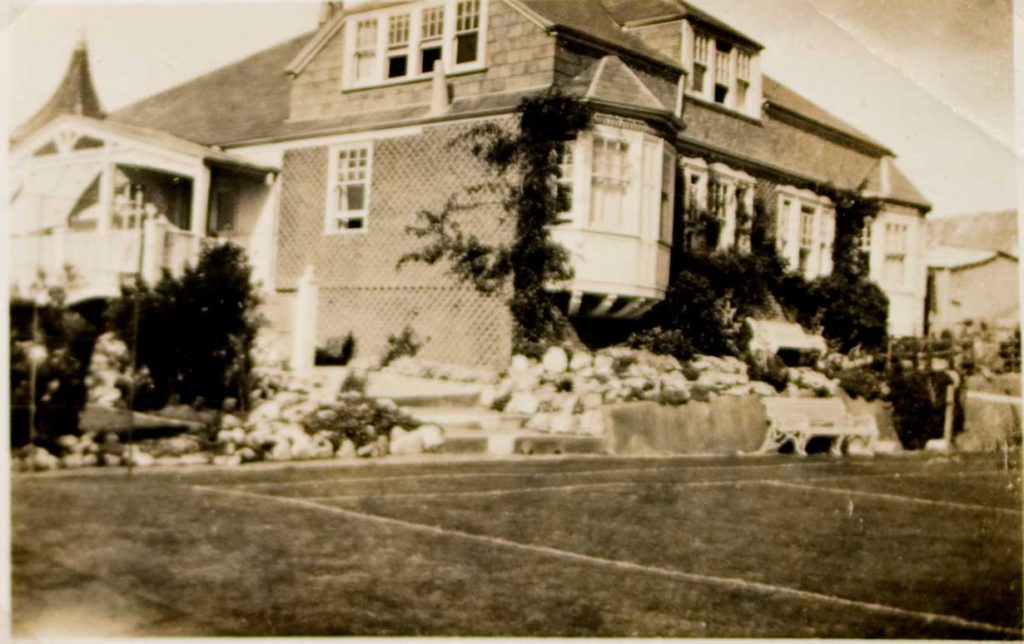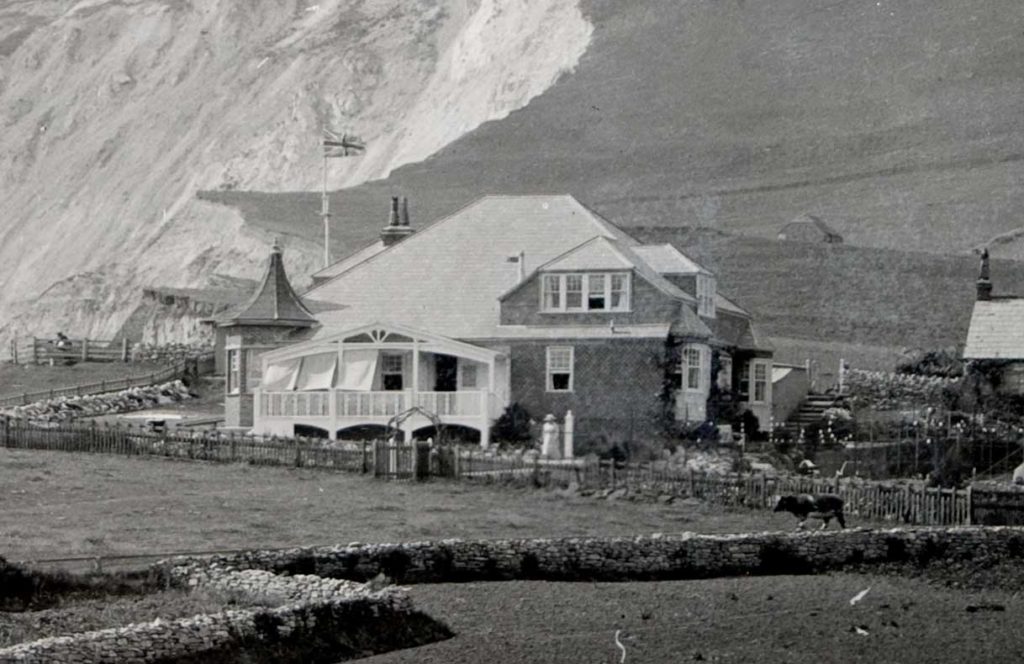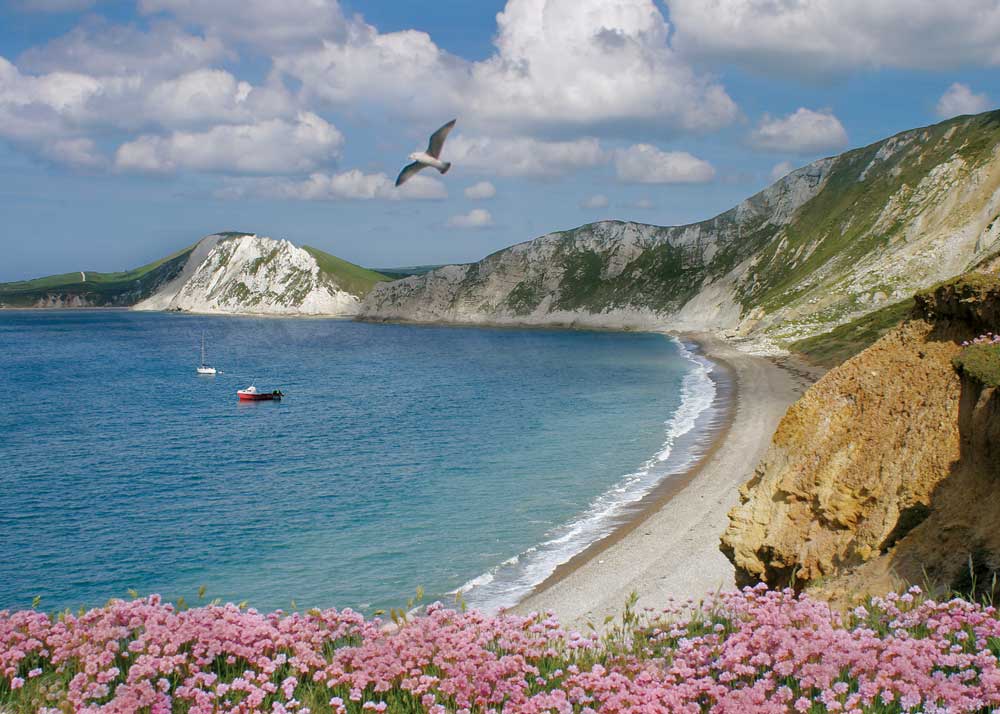
Tyneham Village to Worbarrow Bay is a one-mile walk. The closest car park is actually the village car park, so prepare yourself for a walk. Because of its secluded location, Worbarrow Bay is rarely busy, unlike many of Purbeck’s other beaches.
Welcome to Worbarrow Bay (Tyneham Beach)
The bay which is often referred to as Tyneham Beach is part of the Jurassic coastline which means there are opportunities for fossil hunting. Many of the rocks contain small fossils and apparently fossilized dinosaur footprints are located on Worbarrow Tout.
The opening times for Worbarrow Bay are the same as for Tyneham Village. Dog owners will be pleased to know that dogs are very welcome, and there are lots of opportunities for some very long walks. There are no cafés or restaurants, so make sure to bring a picnic if you are planning on staying for a while.
Because it’s so quiet, it’s a really nice place to just stay and relax for a few hours or perhaps try a spot of fishing! Swimming in Worbarrow Bay is a popular pastime, but do so at your own risk as there are no lifeguards. A walk up to Flower’s Barrow is also highly recommended.

Camping at the bay is not allowed. In fact, there is no accommodation in the immediate vicinity of Tyneham because it is still used regularly by the army. The good news is that there are so many choices for accommodation in the surrounding area. Swanage, Corfe, Wareham and Lulworth Cove are beautiful places to stay. They all have a large selection of campsites, bed & breakfasts and hotels.
Swanage is perhaps the most popular place to stay near Worbarrow Bay. Be prepared though because it can be hard to find accommodation in Swanage during the summer months. Especially during the eight days when the Swanage Carnival is being held.
Worbarrow Tout
Worbarrow Tout is a prominent natural feature located at the end of Tyneham Beach. This stunning limestone sea stack juts out dramatically from the coastline, showcasing the raw and dynamic beauty of the region’s geological history. The term “tout” refers to a high point or lookout, indicating that Worbarrow Tout offers breathtaking panoramic views of the surrounding landscapes.
Worbarrow Tout is a popular destination for hikers, nature enthusiasts, and photographers. Its position along the coast makes it an ideal spot to witness the rugged coastal formations, with its layered rock formations showcasing the passage of time through millennia.
The layers of rock gracefully exposed within the rugged cliffs of Worbarrow Tout serve as an invaluable repository, chronicling the intricate chronicles of Earth’s dynamic history etched across the vast expanse of time. Each stratified layer, meticulously carved by the hands of geological processes over countless millennia, stands as a testament to the shaping forces that have moulded the land we now tread upon.
Enthusiasts of the ancient world find themselves irresistibly drawn to this site, as it resides within the illustrious embrace of the Jurassic Coast, a realm celebrated for its remarkably preserved fossils. These tantalizing remnants of bygone eras are windows into the past, granting us a peerless view of prehistoric marine ecosystems and the diverse array of life that once thrived beneath ancient seas.
Worbarrow Tout’s rock layers and fossils stand as an enduring testament to the dynamic nature of our planet and the remarkable stories it holds within its bosom. As we peer back through the veils of time, these formations beckon us to contemplate the ebb and flow of Earth’s processes, fostering a deeper connection to the majestic unfolding of our planet’s journey.
Map of Worbarrow Bay
The History of Worbarrow Bay (Tyneham Beach)
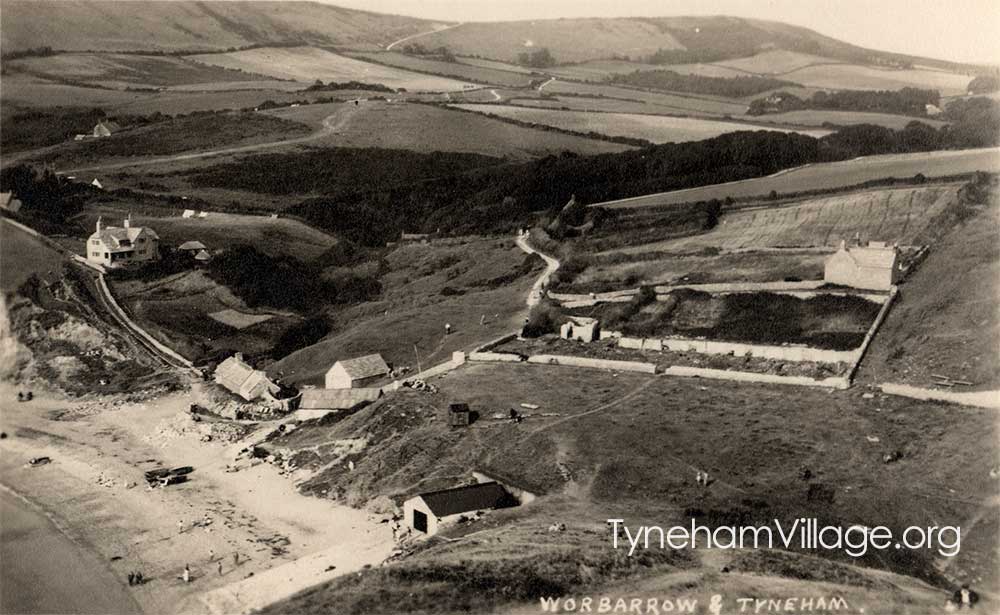
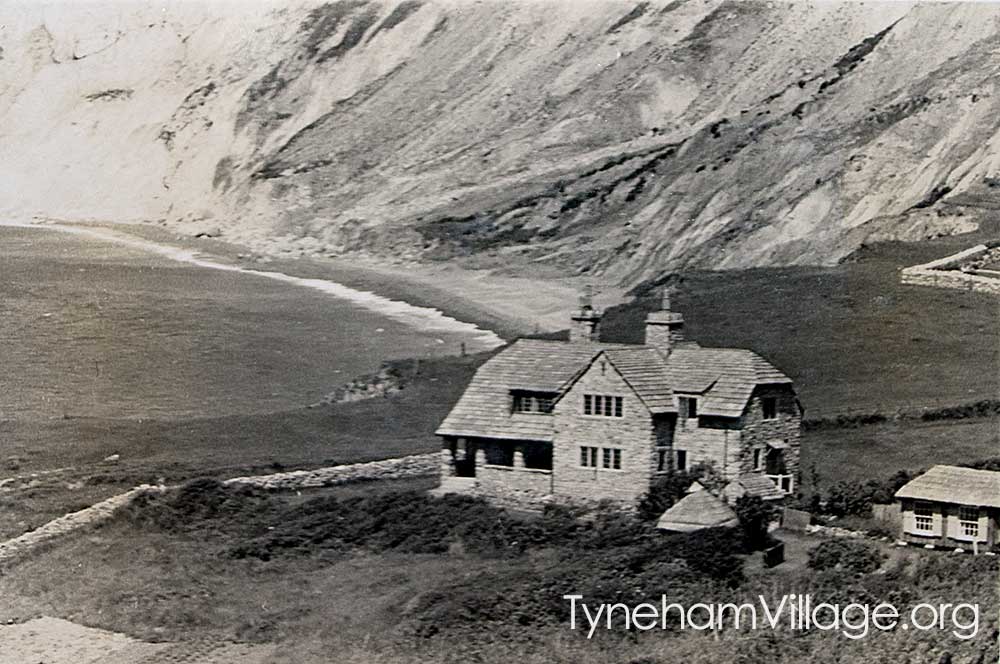
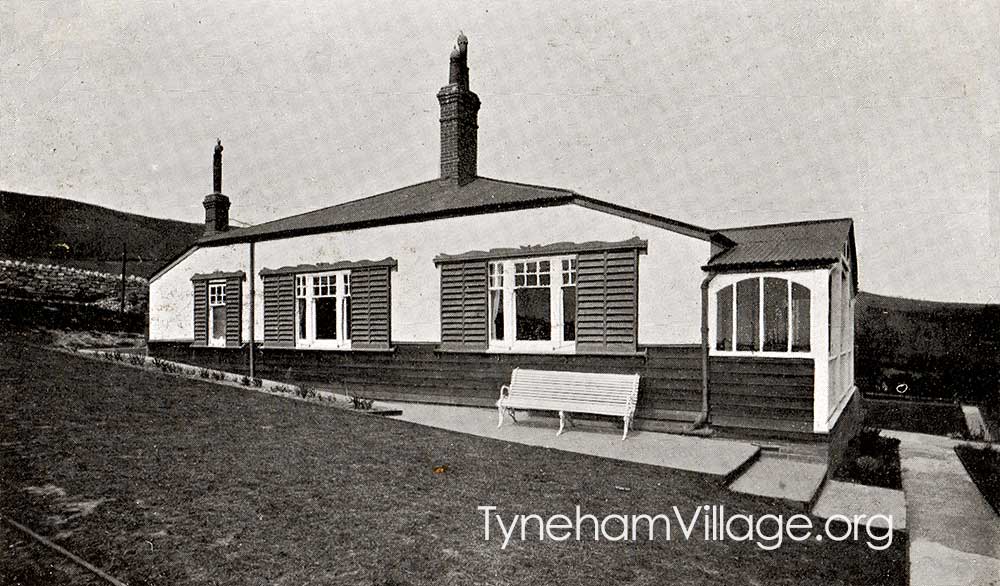
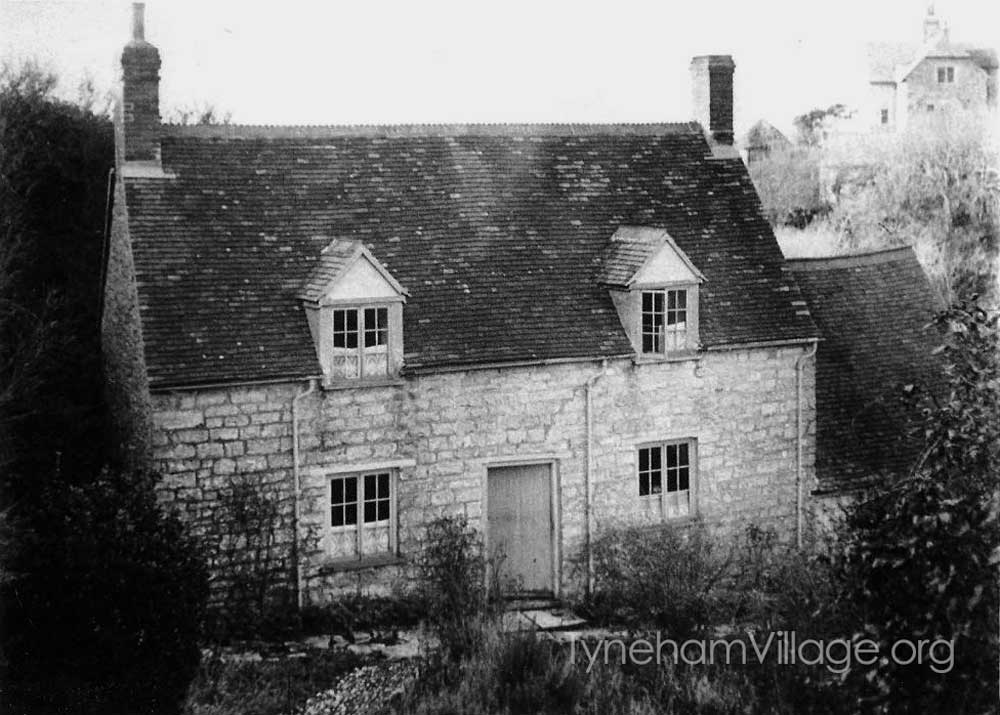
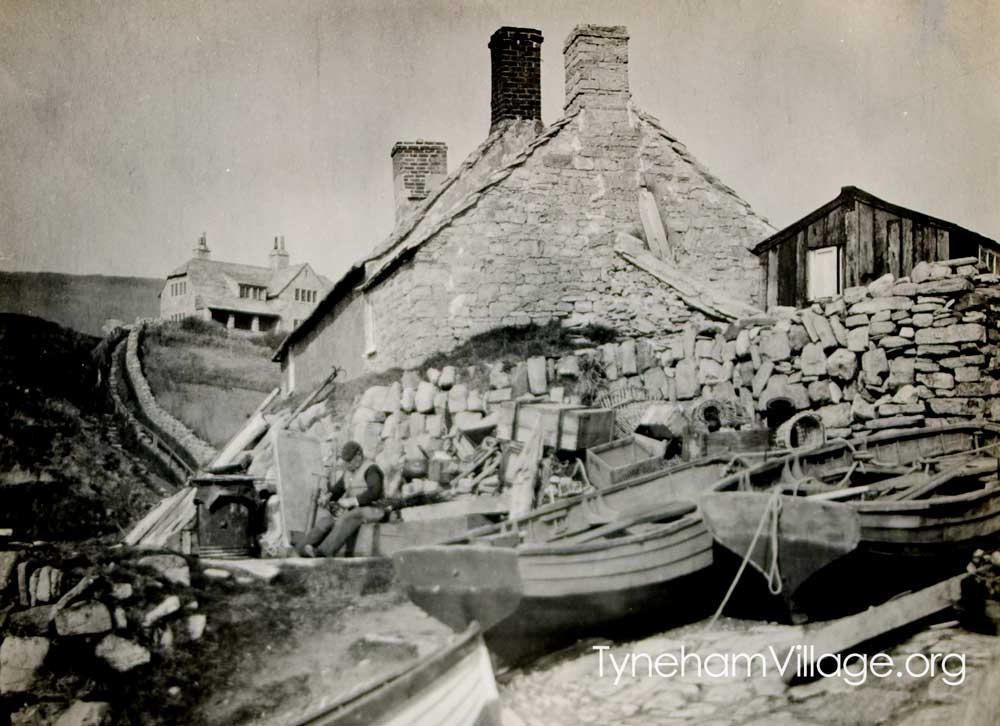
During the early 1900s, Worbarrow Bay had a coastguard station as well as seven cottages. Over fifty people lived here, which is surprising given its remote location. In 1911 when the Coastguard station closed, William Bond purchased it and then one year later had it demolished.
The rumour was that he wasn’t keen on tourists coming to the Bay and didn’t want the Coastguard station or its cottages to be used for holiday homes. After the station closed the population of Worbarrow went into decline. Tyneham Beach was never the same once the coastguards left.
Before the war in the 1930s, despite William Bonds’s wishes, the bay became a popular tourist destination. This was mainly due to the automobile revolution. With more and more people owning cars, Worbarrow became a lot more accessible. Some of the local fishermen took advantage of the tourist trade and provided cooked lobsters and crabs as well as cream teas and beer.
When the forced evacuation of Tyneham began in 1943 only 10 residents remained.
Smuggling in Worbarrow Bay
In the 18th and 19th centuries, Worbarrow Bay became a hotspot for smuggling activities along the southern coast of England. The bay’s natural features, such as its hidden coves and rugged terrain, provided the perfect cover for smugglers seeking to evade authorities and transport contraband goods into the country.
Local fishermen, sailors, and even villagers themselves often became involved in smuggling operations, driven by economic incentives and a desire to outwit the customs officials. Goods such as brandy, tobacco, tea, and other valuable commodities were smuggled ashore under the cover of darkness, and hidden in secret locations to await distribution.
The tales of smuggling in Worbarrow Bay and Durdle Door are woven with stories of secret tunnels, hidden compartments, and ingenious methods to deceive the law. These smugglers became skilled at navigating the treacherous waters and exploiting the rugged landscape to their advantage.
However, the allure of illicit trade was not without its risks. The authorities were vigilant, and customs officers were determined to thwart smuggling operations. Raids, arrests, and conflicts between smugglers and officials were common, adding an air of danger to the already daring world of smuggling.
As time passed and law enforcement became more effective, the era of rampant smuggling in Worbarrow Bay waned. The stories of these daring escapades have become a part of the bay’s rich tapestry, leaving behind a legacy of intrigue and adventure that lingers in the collective memory.
Today, as visitors stroll along the tranquil shores of Worbarrow Bay, they are reminded of the hidden history that lies beneath the surface. The beauty of the bay serves as a backdrop to tales of daring smugglers and the echoes of a bygone era when Worbarrow Bay’s hidden coves provided refuge for those who operated in the shadows of the past.
The Buildings of Worbarrow Bay
The Coastguard Station
Once standing as a sentinel on the shores of Tyneham Village, the Coastguard Station held a watchful gaze over the ever-changing sea. However, its presence was fleeting, as it was destined to be erased from the landscape, leaving behind a mere memory.
In the year 1912, the Coastguard Station met its fate in the form of demolition. What was once a hub of vigilance and maritime security vanished from the village’s vista, leaving behind an empty space that was once filled with purpose and activity.
The Coastguard Station’s story was one of vigilance and responsibility. Its inhabitants watched over the waves, ensuring the safety of seafarers and coastal communities. Their diligence was etched into the station’s walls, a constant reminder of their commitment to safeguarding lives and livelihoods.
As the station’s walls crumbled and its timbers fell, a chapter closed on its existence. The memories of those who manned its posts, the stories that unfolded within its rooms, and the history it bore were scattered to the winds. The station’s vanishing marked the end of an era—a silent farewell to a structure that had served as a guardian of the village for years.
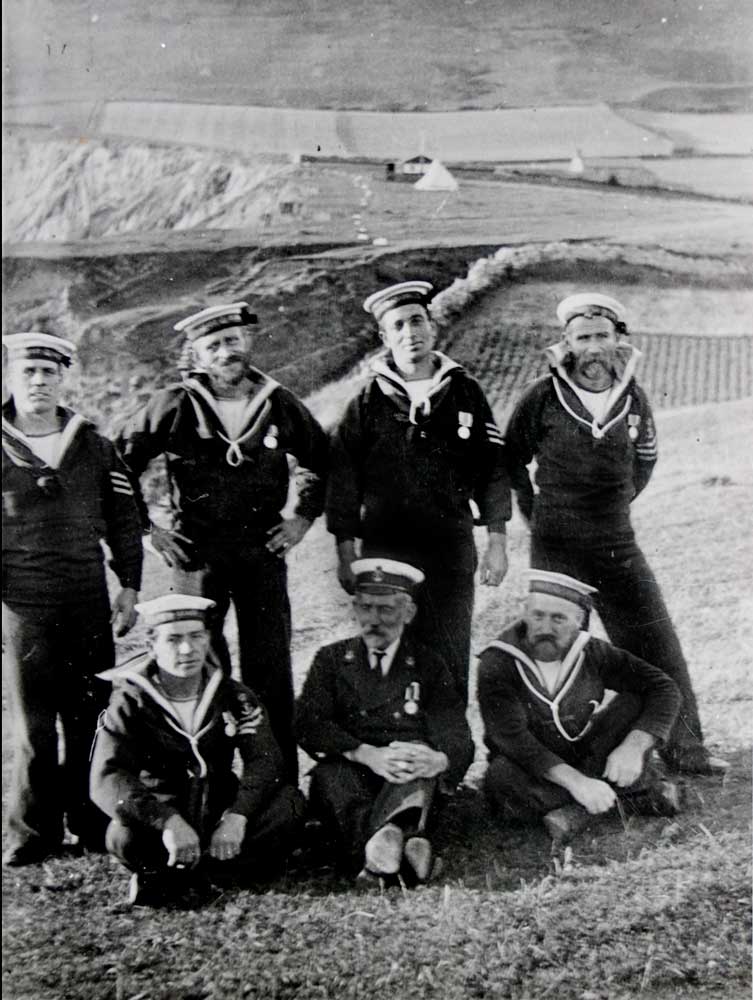
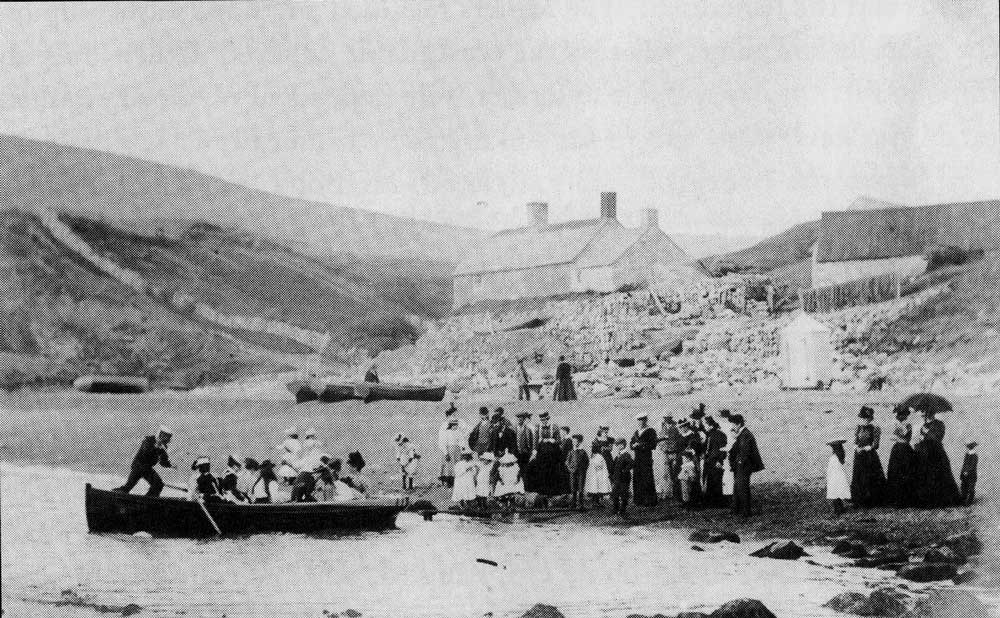
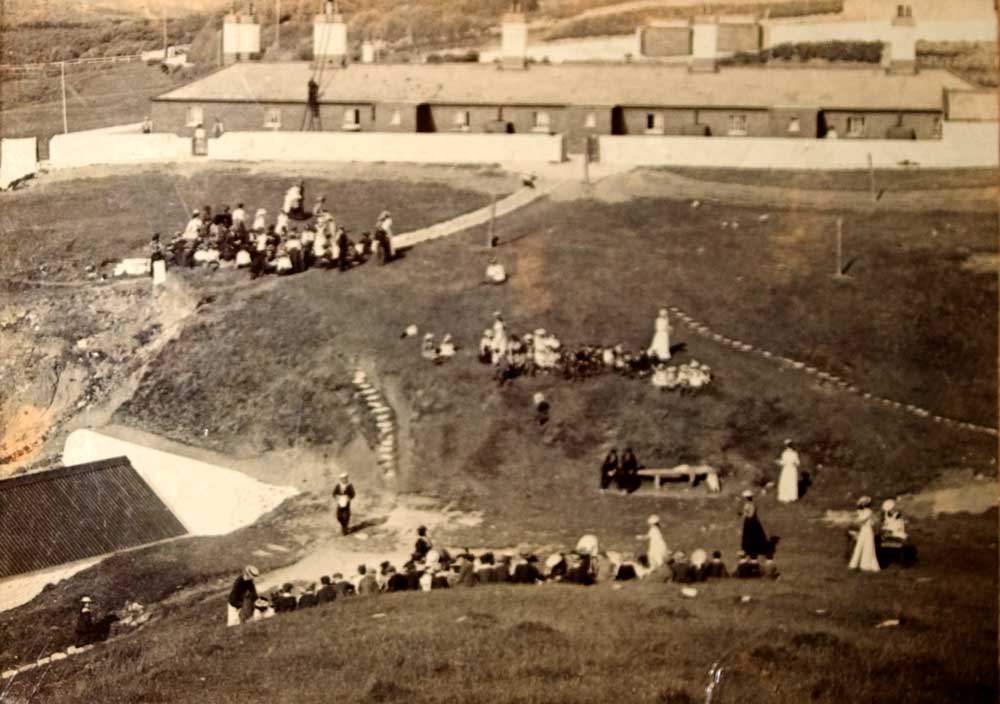
Fern Hollow
Nestled in the serene embrace of Tyneham Village, Fern Hollow stood as a haven of warmth and hospitality, curated by its inhabitants, Charlie and Harriet. Their modest abode was more than just a cottage; it was a sanctuary of simplicity and a hub of lively interactions that enriched the lives of those who crossed its threshold.
Charlie and Harriet, despite not having children of their own, opened their hearts and homes to young guests who sought refuge within the cosy confines of Fern Hollow. The cottage’s quaint charm and the welcoming embrace of its hosts transformed it into a place of joyful activity, a hub where stories were shared, laughter echoed, and friendships blossomed.
However, the winds of change arrived with the shadow of World War II and the subsequent evacuation of Tyneham Village. Charlie and Harriet, like the other villagers, faced the unsettling task of uprooting their lives and leaving behind the homes they had cherished. Relocated to Stoborough, they found themselves in a new landscape, far from the familiar surroundings of Fern Hollow and Worbarrow Bay.
For Charlie, the transition proved to be bittersweet. At the remarkable age of 93, he carried with him the weight of history and the memories of a life well-lived. Yet, only two weeks after being relocated, he breathed his last—a poignant reminder of the impermanence of life and the impact that cherished places and connections can leave.


Mintern’s Cottage
The Mintern family’s legacy was intricately woven into the very walls of the cottage. A small dairy, attached to the side of the building, symbolized their commitment to providing essentials for the community. Milk and butter flowed from this humble establishment, nurturing both bodies and bonds among the villagers.
Even as the tides of war swept through Worbarrow Bay, the Mintern family’s dedication to their community remained unwavering. In 1943, as the bay was evacuated, the Minterns persisted in supplying Tyneham Village with the dairy products that had become synonymous with their name. Their cottage was a haven of productivity and care, with the sounds of labour echoing from the dairy—a constant reminder of their role in sustaining the village’s daily life.
As the pages of history turned, Mintern’s Cottage stood as a symbol of both continuity and resilience. The legacy of the Mintern family was etched into the routines of Worbarrow Bay, an embodiment of the interconnectedness that defined village life.
Today, Mintern’s Cottage remains a poignant reminder of the families who called Tyneham Village and Worbarrow Bay their home, and the contributions they made to the collective tapestry of history. In its weathered walls and the echo of bygone labour, the cottage continues to tell a story of dedication, community, and the sustenance that nourishes both body and spirit.
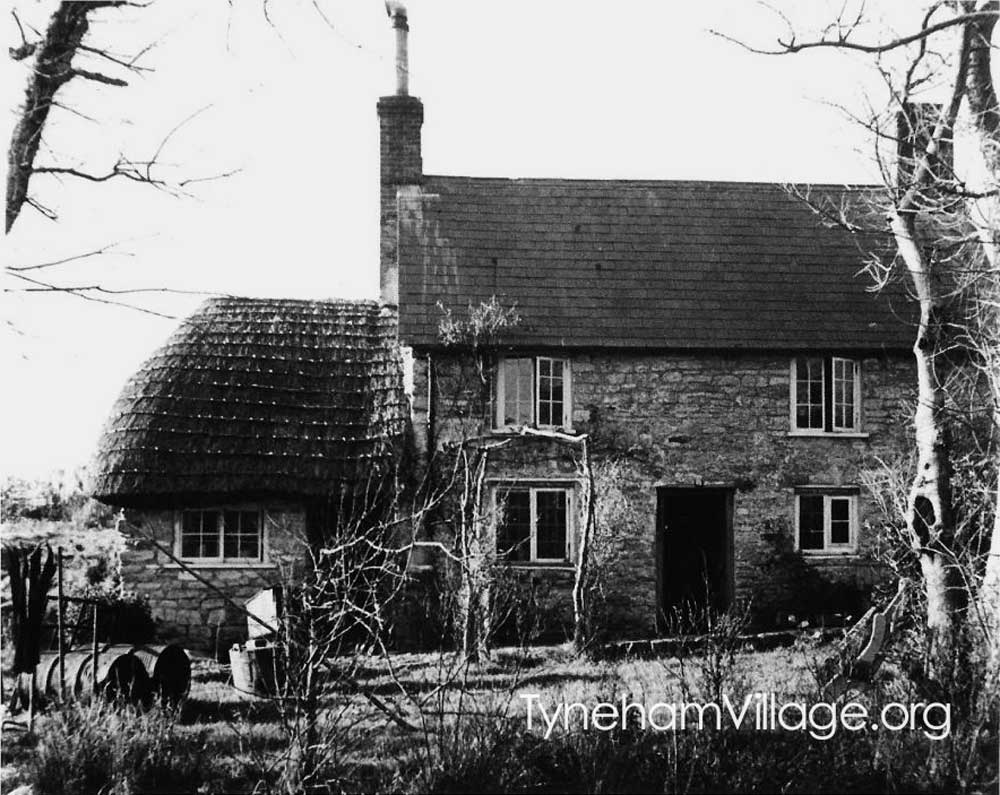
Rose Cottage
For Jack and Miggie Miller, Rose Cottage was more than just a dwelling; it was a haven where their shared journey unfolded. From the early days of their marriage until 1913, the cottage bore witness to the joys, challenges, and moments that defined a life lived together.
The cottage’s name, “Rose Cottage,” held a special significance, echoing the bonds that intertwined Jack and Miggie’s lives. The roses that adorned its door were a living tribute to Miggie’s maiden name, a symbol of her presence and the enduring love that flourished within its walls.
The picturesque allure of Rose Cottage mirrored the beauty of the relationship it sheltered. Its walls saw the laughter of shared stories, the warmth of togetherness, and the quiet moments that make a house a home. The cottage became a sanctuary where the Millers’ love story was etched into every nook and cranny.
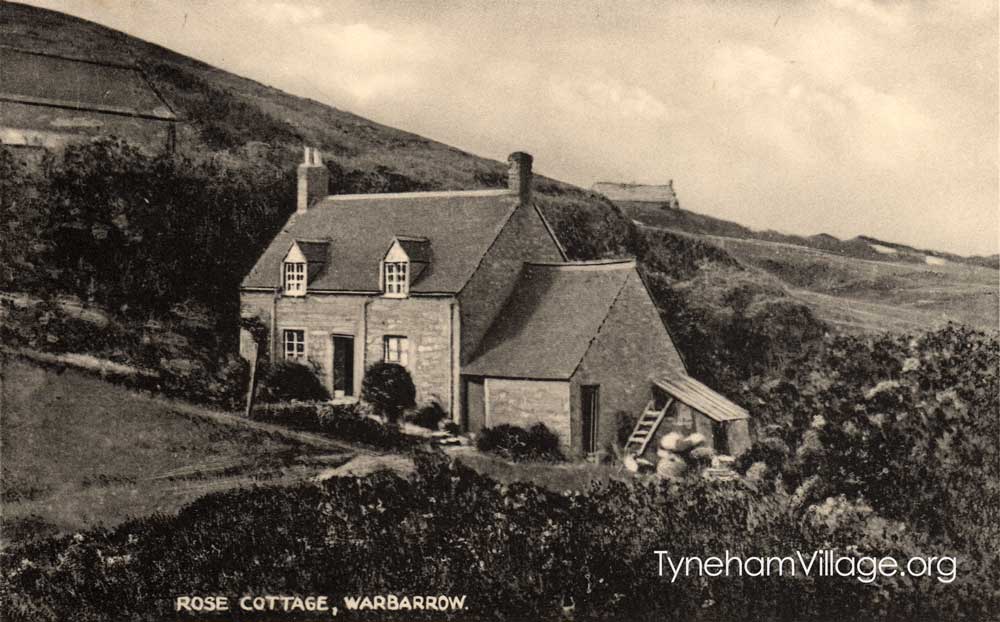
Sea Cottage
The transition from Rose Cottage to Sea Cottage marked a new chapter in Jack and Miggie’s journey. The move symbolized a shift in their lives, as they left behind one cherished home to embrace another. For over three decades, Sea Cottage was the canvas upon which their story was painted.
With the rhythmic waves as their soundtrack, Jack and Miggie lived out their days in the heart of Sea Cottage. The cottage became a sanctuary where their laughter, companionship, and the bonds of shared experiences flourished. The proximity to the sea offered a constant reminder of the beauty and power of nature, a backdrop that enhanced the significance of their everyday moments.
As the years rolled by, Sea Cottage witnessed the ebb and flow of life’s tides. The shoreline became a part of their daily routine, a place where footsteps etched their presence into the sand, and memories were woven into the fabric of the landscape.
However, the winds of change blew through Tyneham Village, bringing with them the necessity of evacuation. Jack and Miggie, like so many others, bid farewell to the place that had cradled their lives for decades. They were relocated to Langton Matravers, leaving behind the cottage that had been both their sanctuary and their canvas.

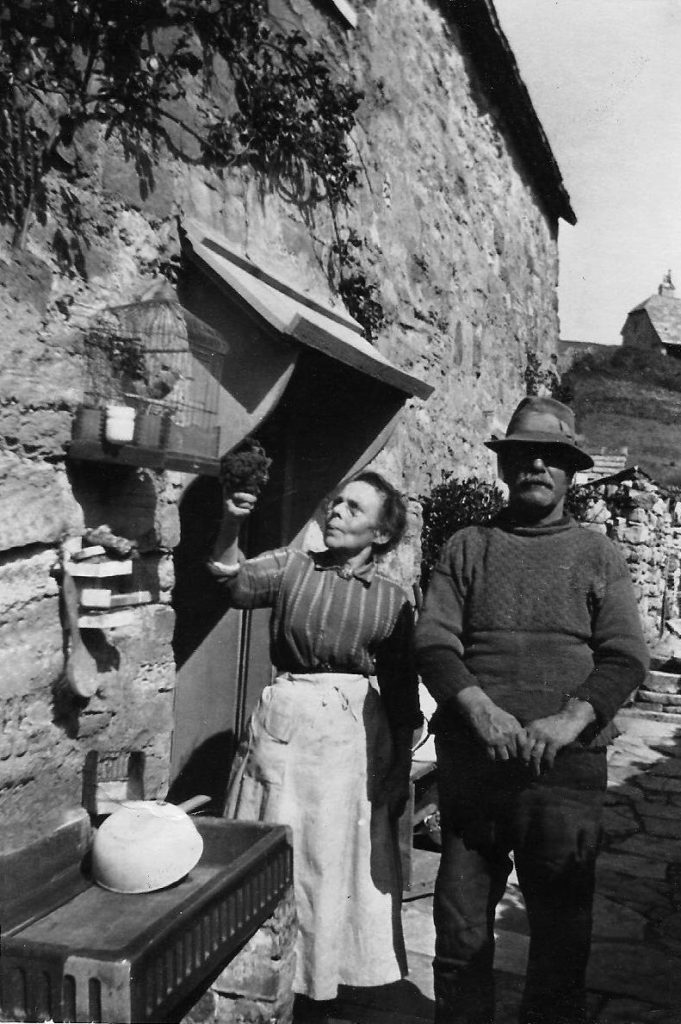
Sheepleaze
Standing on the cliff above the beach, Sheepleaze had wonderful views across the bay all the way to the Isle of Portland. It was built in 1910 by Warwick Draper who was a barrister from London who got permission from the then landowner, William Bond.
The Draper family spent many summers at Sheepleaze up until the evacuation.
When they were forced to give up their beautiful summer retreat, Philip Draper who was Warwick’s eldest son was very much aggrieved. The thought of losing their summer retreat where they had spent so many summers was too much to bear.
After the war, Phillip tried to get his property back. He had many influential friends but they had no success in regaining the property. Phillip became a prominent figure in the Tyneham Action Group but it was all to no avail. The government kept the land and the property.
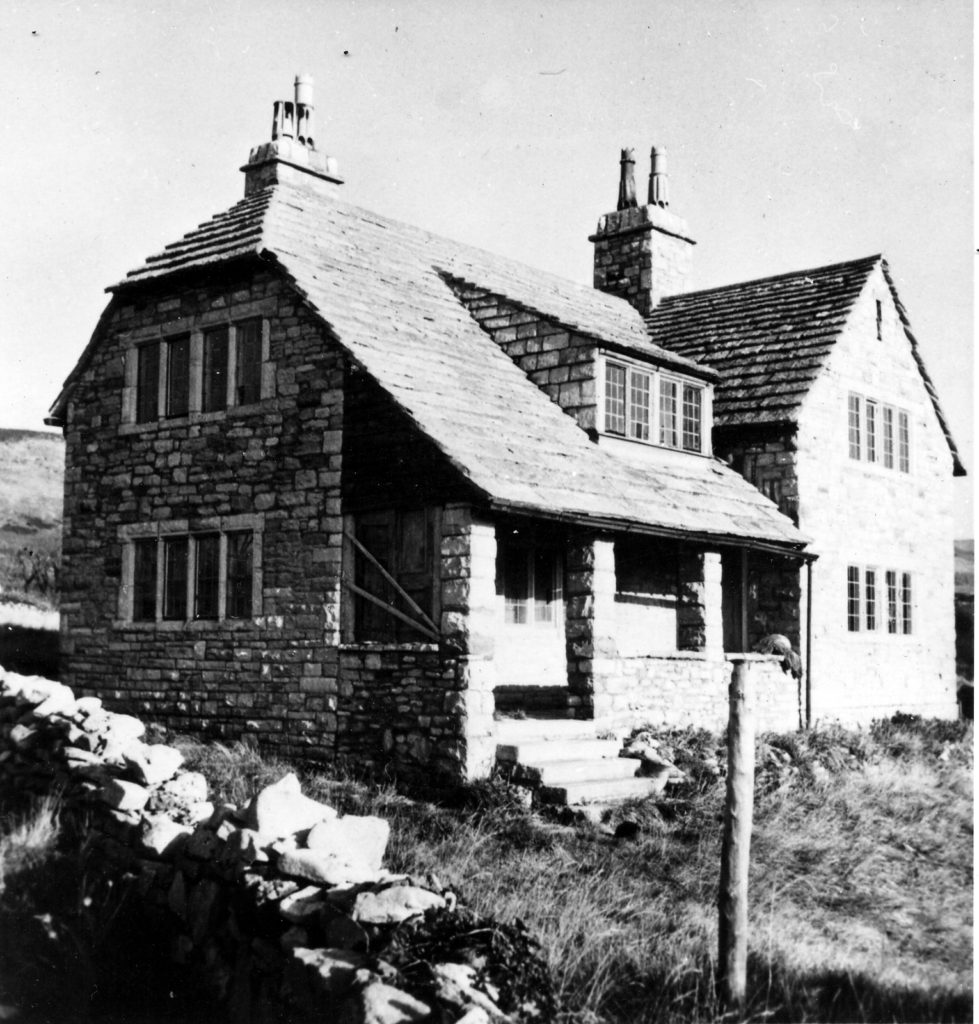
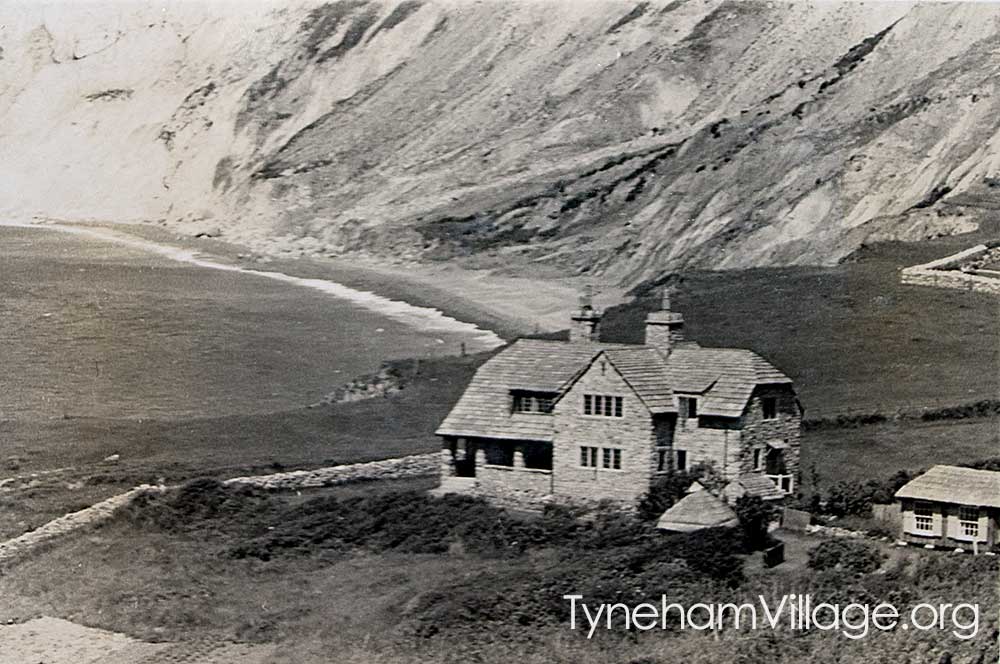
The Bungalow
The story of The Bungalow was one of expansion and transformation. From its humble beginnings, it blossomed into a grand property with seven bedrooms by 1920, becoming a hub of life and activity within the village. Its walls held the echoes of laughter, the whispers of secrets, and the warmth of shared moments.
Mary and John Wheeler were the heart of The Bungalow. Their love and care radiated throughout its rooms, making it a haven for their four adopted children. As the family grew, so did the home that housed them, a tangible manifestation of their evolving journey.
The corridors of The Bungalow echoed with the footsteps of the Wheelers and the joy of the adopted children who found a place of belonging within its walls. The home’s growth mirrored the growth of their family, expanding to accommodate the love and life they nurtured.
When the tumultuous events of the war led to the evacuation of Tyneham Village, the story of The Bungalow continued. Mary’s niece, Maud, found solace within its rooms, making it her home in the midst of uncertainty.

